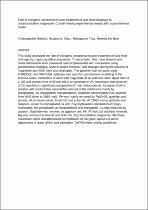 ResearchSpace
ResearchSpace
Fate of inorganic contaminants post treatment of acid mine drainage by cryptocrystalline magnesite: Complimenting experimental results with a geochemical model
JavaScript is disabled for your browser. Some features of this site may not work without it.
- ResearchSpace
- →
- Research Publications/Outputs
- →
- Journal Articles
- →
- View Item
| dc.contributor.author |
Masindi, Vhahangwele

|
|
| dc.contributor.author |
Gitari, MW

|
|
| dc.contributor.author |
Tutu, H

|
|
| dc.contributor.author |
De Beer, Morris

|
|
| dc.date.accessioned | 2017-07-28T08:54:46Z | |
| dc.date.available | 2017-07-28T08:54:46Z | |
| dc.date.issued | 2016-03 | |
| dc.identifier.citation | Masindi, V., Gitari, M.W., Tutu, H. and De Beer, M. 2016. Fate of inorganic contaminants post treatment of acid mine drainage by cryptocrystalline magnesite: Complimenting experimental results with a geochemical model. Journal of Environmental Chemical Engineering, doi:10.1016/j.jece.2016.03.020. | en_US |
| dc.identifier.uri | http://www.sciencedirect.com/science/article/pii/S2213343716300999? | |
| dc.identifier.uri | http://hdl.handle.net/10204/9288 | |
| dc.description | Copyright: 2016 Elsevier. Due to copyright restrictions, the attached PDF file contains the abstract of the full text item only. For access to the full text item, kindly contact the publisher's website. | en_US |
| dc.description.abstract | This study assessed the fate of inorganic contaminants post treatment of acid mine drainage by cryptocrystalline magnesite. To accomplish that, neutralization and metal attenuation were evaluated and complemented with simulations using geochemical modeling. Mineral phase formation and changes during the reaction of magnesite and AMD were also evaluated. The geochemical computer code PHREEQC and WATEQ4 database was used for geochemical modelling of the process water. Interaction of AMD with magnesite at an optimum solid: liquid ratio of 1:100 and contact time of 60 min led to an increase in pH, reaching a maximum pH of 10, resulting in significant precipitation of most metal species. Increase of pH in solution with contact time caused the removal of the metal ions mainly by precipitation, co-precipitation and adsorption. Sulphate concentration was lowered from 4640 down to 1910 mg/L. Fe was mainly removed as Fe(OH)(sub3), goethite, and jarosite, Al as basaluminite, boehmite and jurbanite, Al(OH)3 and as gibbsite and diaspore. Al and Fe precipitated as iron (oxy)-hydroxides and aluminium (oxy)-hydroxides. Mn precipitated as rhodochrosite and manganite. Ca was removed as gypsum. Sulphate was removed as gypsum, and Fe, Al hydroxyl sulphate minerals. Mg was removed as brucite and dolomite. Cryptocrystalline magnesite effectively neutralized AMD and attenuated concentration of inorganic species to within department of water affairs and sanitation (DWAS) water quality guidelines. | en_US |
| dc.language.iso | en | en_US |
| dc.publisher | Elsevier | en_US |
| dc.relation.ispartofseries | Worklist;16747 | |
| dc.subject | Acid mine drainage | en_US |
| dc.subject | AMD | en_US |
| dc.subject | Magnesite | en_US |
| dc.subject | Toxic metals | en_US |
| dc.subject | Sulphate | en_US |
| dc.subject | Geochemical modelling | en_US |
| dc.title | Fate of inorganic contaminants post treatment of acid mine drainage by cryptocrystalline magnesite: Complimenting experimental results with a geochemical model | en_US |
| dc.type | Article | en_US |
| dc.identifier.apacitation | Masindi, V., Gitari, M., Tutu, H., & De Beer, M. (2016). Fate of inorganic contaminants post treatment of acid mine drainage by cryptocrystalline magnesite: Complimenting experimental results with a geochemical model. http://hdl.handle.net/10204/9288 | en_ZA |
| dc.identifier.chicagocitation | Masindi, Vhahangwele, MW Gitari, H Tutu, and Morris De Beer "Fate of inorganic contaminants post treatment of acid mine drainage by cryptocrystalline magnesite: Complimenting experimental results with a geochemical model." (2016) http://hdl.handle.net/10204/9288 | en_ZA |
| dc.identifier.vancouvercitation | Masindi V, Gitari M, Tutu H, De Beer M. Fate of inorganic contaminants post treatment of acid mine drainage by cryptocrystalline magnesite: Complimenting experimental results with a geochemical model. 2016; http://hdl.handle.net/10204/9288. | en_ZA |
| dc.identifier.ris | TY - Article AU - Masindi, Vhahangwele AU - Gitari, MW AU - Tutu, H AU - De Beer, Morris AB - This study assessed the fate of inorganic contaminants post treatment of acid mine drainage by cryptocrystalline magnesite. To accomplish that, neutralization and metal attenuation were evaluated and complemented with simulations using geochemical modeling. Mineral phase formation and changes during the reaction of magnesite and AMD were also evaluated. The geochemical computer code PHREEQC and WATEQ4 database was used for geochemical modelling of the process water. Interaction of AMD with magnesite at an optimum solid: liquid ratio of 1:100 and contact time of 60 min led to an increase in pH, reaching a maximum pH of 10, resulting in significant precipitation of most metal species. Increase of pH in solution with contact time caused the removal of the metal ions mainly by precipitation, co-precipitation and adsorption. Sulphate concentration was lowered from 4640 down to 1910 mg/L. Fe was mainly removed as Fe(OH)(sub3), goethite, and jarosite, Al as basaluminite, boehmite and jurbanite, Al(OH)3 and as gibbsite and diaspore. Al and Fe precipitated as iron (oxy)-hydroxides and aluminium (oxy)-hydroxides. Mn precipitated as rhodochrosite and manganite. Ca was removed as gypsum. Sulphate was removed as gypsum, and Fe, Al hydroxyl sulphate minerals. Mg was removed as brucite and dolomite. Cryptocrystalline magnesite effectively neutralized AMD and attenuated concentration of inorganic species to within department of water affairs and sanitation (DWAS) water quality guidelines. DA - 2016-03 DB - ResearchSpace DP - CSIR KW - Acid mine drainage KW - AMD KW - Magnesite KW - Toxic metals KW - Sulphate KW - Geochemical modelling LK - https://researchspace.csir.co.za PY - 2016 T1 - Fate of inorganic contaminants post treatment of acid mine drainage by cryptocrystalline magnesite: Complimenting experimental results with a geochemical model TI - Fate of inorganic contaminants post treatment of acid mine drainage by cryptocrystalline magnesite: Complimenting experimental results with a geochemical model UR - http://hdl.handle.net/10204/9288 ER - | en_ZA |





